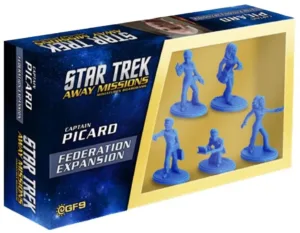 It feels like just a couple of months ago that I was hearing about this new miniatures game called Star Trek: Away Missions, and now there is already a new wave of expansions for it. I think it felt like that, because it was and now there is. I had some pretty good things to say about the core game and its initial expansions, so I was looking forward to seeing what direction they took with the next release.
It feels like just a couple of months ago that I was hearing about this new miniatures game called Star Trek: Away Missions, and now there is already a new wave of expansions for it. I think it felt like that, because it was and now there is. I had some pretty good things to say about the core game and its initial expansions, so I was looking forward to seeing what direction they took with the next release.
As someone of the correct opinion that Picard is the best Star Trek captain, I’m pretty happy to see him coming to this game in his own expansion, alongside the House of Duras. But will the expansion live up to the legend? Lets take a look.
Expansions Overview:
There were two expansions that released alongside the core set: Chancellor Gowron and Commander Sela. These two new expansions follow the same format with a new Commander (or two, in the case of the House of Duras) and a team to support them, along with the core missions, mission deck, and support deck that goes along with a team. The mission and support cards can be used to customize a deck to suit your plan, with the missions going in different directions than the core set and expansion teams in the same factions (Riker’s away team in the core set, and Gowron’s expansion, respectively).

The main thing that sets these sets apart from the first two expansions is a very welcome change: the mission and support cards come with a prebuilt option like the core set’s teams. This was missing in the initial expansions and made it a little harder to get them into the game quickly. Since I think the deck-building aspect is more intimidating, it is good they went back to it with these sets. Hopefully, it is a trend that will continue in future sets, should there be any.
Integrating these expansions is simple. You just use the characters and the included decks in place of one of your existing teams. The cards can be mixed, and the new oversized core missions are interchangeable with existing ones, but the missions and support cards included here are designed to work best with the included characters.

Game Experience with the Expansions:
These expansions faced a challenge: to differentiate themselves from the away teams and factions that had been released previously. There’s certainly a danger in them being just “more of the same.” They make an effort to avoid that and are largely successful. The missions have new, distinct objectives so that a Captain Picard team functions differently than a Commander Riker team, or a Duras sisters team functions differently than a Gowron team.
For example, the Picard expansion is more focused on Diplomacy tests (Picard himself has two Diplomacy Specializations, so he rolls two extra dice when testing Diplomacy). You might say “but that’s just rolling dice with a different label” and you would be correct. The Mission and Support cards take on a different theme to support the idea of Diplomacy. Prominent among them are cards that are tagged Negotiations. That is, they do something for your opponent as well when you play them or score them. In the core set, Riker’s away team is largely focused on repairing and investigating the ship to score points. Picard, on the other hand, wants to give deals to get your Missions scored (and do it in a way that ideally puts you ahead in the long run!). This is subtle at times, but it does feel different over the course of the game.

The differences between the Duras expansion and the previous Klingon expansion with Gowron are bit less subtle. While there are some distinctly combative Klingon elements in the supporting cards (like a vow of revenge when a friendly character is neutralized), the overall character of the Mission and Support cards for this Klingon expansion is sneaky and decidedly more. . . Romulan. Indeed, unlike their Gowron team counterparts, these Klingons have the Treachery Specialization in ample supply, much like the Romulans. Your objectives are ones of subterfuge, like collecting weapons for an arms deal. While you can engage with the enemy to complete some of these objectives, it is often better to avoid it. For example, some cards are thwarted if a character with the Security Specialization can see what is going on. Appropriately, Worf is the Bane of the Duras family.
One other point that is noteworthy about the Duras expansion: Lursa and B’Etor are both the away team’s commander. They are separate minis and have their own character cards, but are both listed as Commander, and their ability is contingent upon their counterpart not being neutralized. While for the most part on these teams, each individual has a role to fill, the two of them being linked does give their team a little bit of a spin, even though the mechanical implications do not seem huge.

The gameplay is in many ways the same as the core set and the original expansions. You’re getting actions or bonus actions, activating each character on the team, performing tests or attacks, rolling dice, and completing missions. At a certain face value, this isn’t much different than the core set, and perhaps that is to be expected from what is essentially the first post-release expansions (the first two were released alongside the core set).
That’s really only at face value though. While many of the things you’re doing are the same, the way you’re going about them feel different. Picard offering some cards to his opponent so he can do something in furtherance of his own objective does feel different than Data repairing a console while Riker and Worf hold down the approaching drones with phaser fire. Lursa and B’Etor sneaking around to get through subtlety what their brother could not get by force feels different than Gowron smashing faces. It’s a thematic win for these sets.

One thing that is a bit unclear (to the point where GaleForce9 had to clarify it in an FAQ shortly after these expansions were released) was whether or not these characters can be integrated with the other teams in their factions. The answer is yes. . . sort of. Each expansion so far has one character with the tag Specialist. In the core set for Federation, that is Commander Shelby; in the Picard expansion, it is Geordi. As intended, these Specialists are the only characters that can be swapped between teams. That is, Picard is always with Wesley, Dr Crusher, and Troi, and he can finish his team with Geordi, but not Data or Worf. This is a bit disappointing and brings my estimation of the game’s customization down a few notches. It does probably make it easier to balance, however, so that can be viewed as a plus.
Final Thoughts:
If someone didn’t like the game to start with, this expnasion doesn’t change enough to move the needle the other direction. However, for someone who liked the core set, this is a good pick-up. Despite being somewhat less customizable than I had hoped, these do provide more variety of gameplay, and add some popular characters from the franchise into the mix in thematically appropriate ways.
 Hits:
Hits:
• Successfully differentiates these away teams from the previous ones in ways that are on-point with the franchise.
• Adds popular characters to the game (Picard is a better captain than Kirk – that’s right, I said it).
• Easy to integrate with the existing game with a low amount of learning.
Misses:
• As with the core set, the minis have an exaggerated style, though there are fewer identification issues with these.
• The lack of full team-building is disappointing.





















